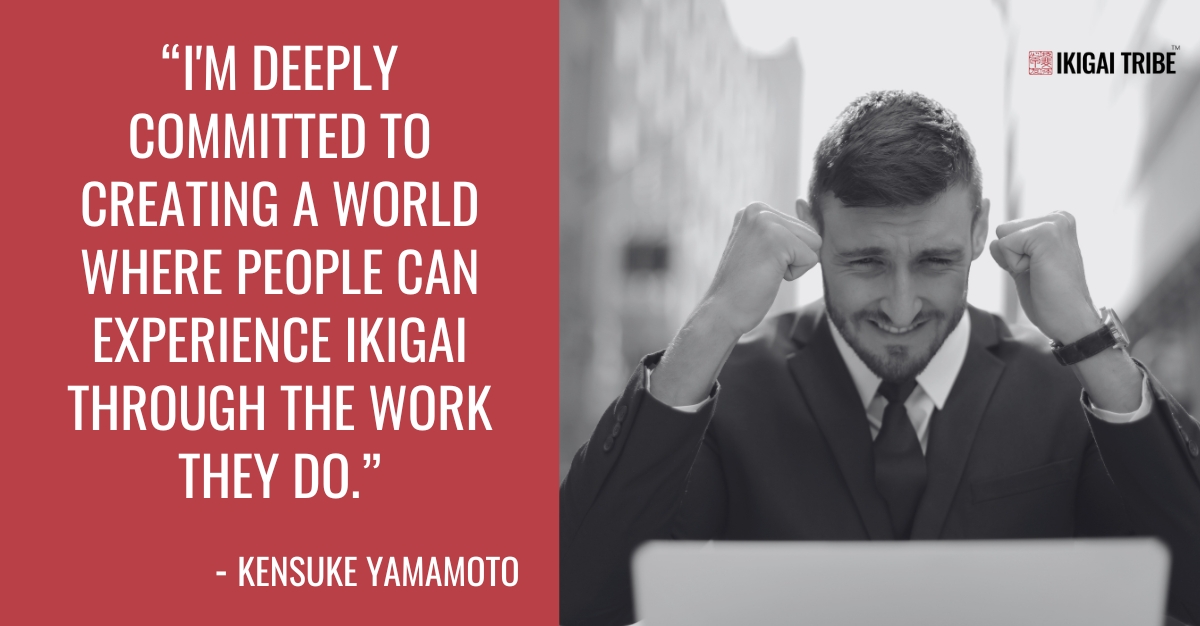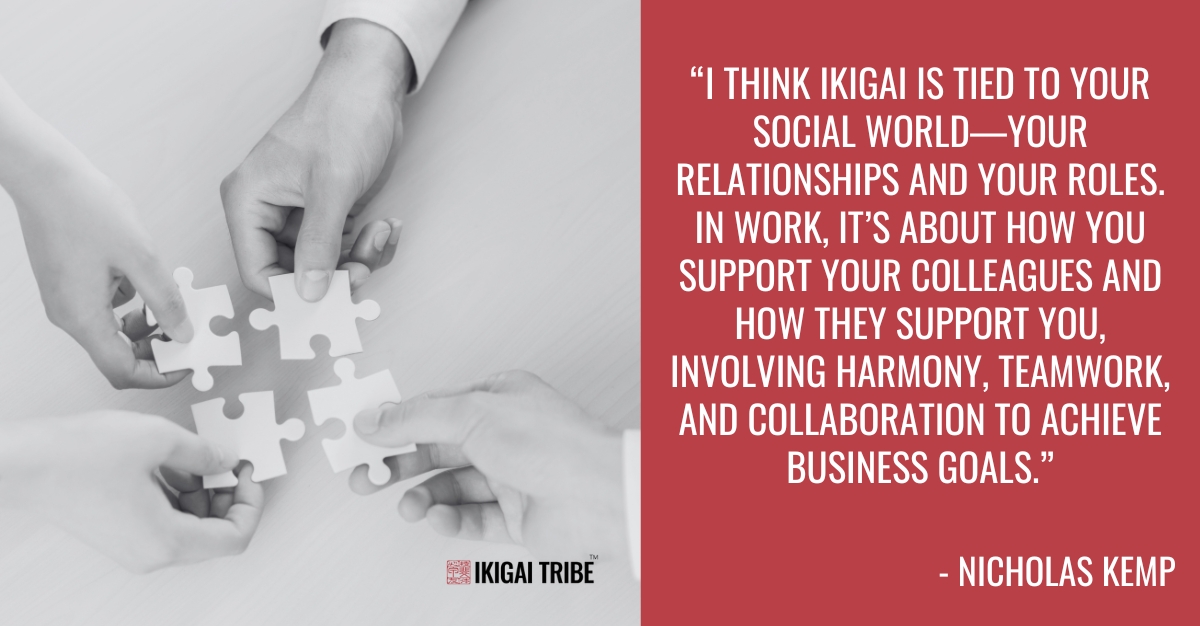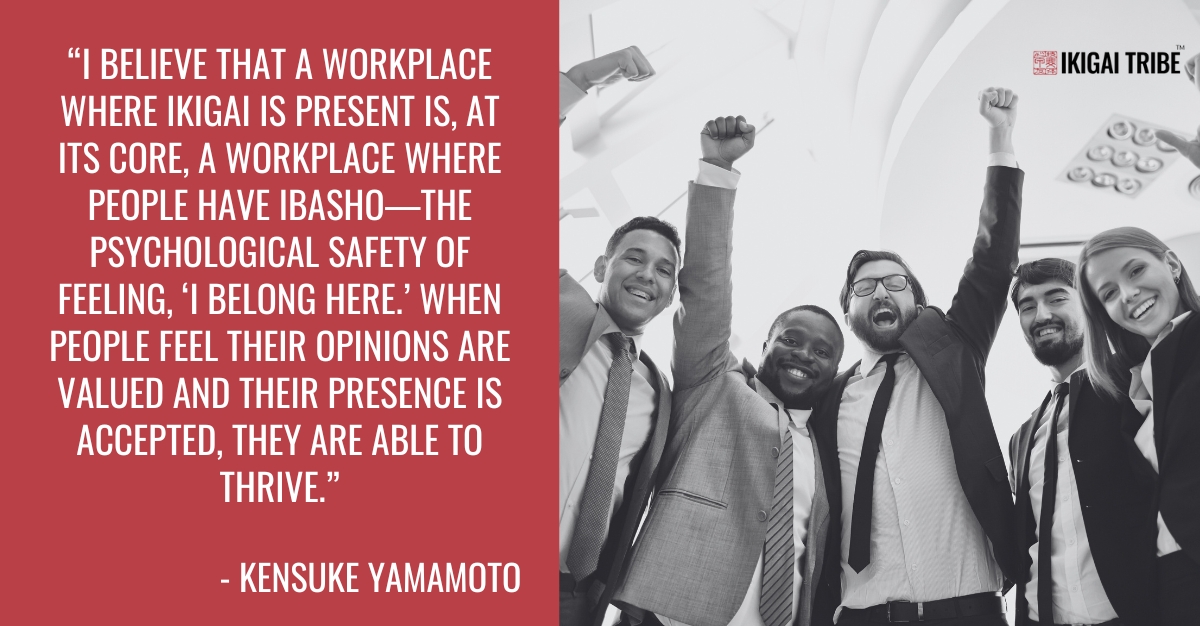Can ikigai be experienced at work?
In this episode of the Ikigai Podcast, Nick speaks with Kensuke Yamamoto about discovering and cultivating ikigai through the work we do.
Podcast Highlights
- Kensuke’s background. Kensuke shares a bit about himself.
- Business landscape in Japan. Kensuke offers his perspective.
- Workplace culture in Japan. Kensuke shares how it has evolved over time.
- Ikigai at work. Kensuke talks about the terms yarigai and hatarakigai, which relate to having ikigai at work.
- Varying perspectives on work and ikigai. Kensuke discusses the differences in perspectives on work and ikigai between Japanese and Western cultures.
- Vanto Group’s vision. Kensuke shares his company’s vision.
- Vanto’s three laws. Nick and Kensuke discuss the company’s three laws.
- Difficulties in cultivating ikigai at work. Kensuke shares the barriers that prevent people from finding ikigai in the workplace.
- An ideal workplace. Kensuke shares what he believes an ideal workplace with ikigai would look like.
- Kensuke’s personal ikigai. Kensuke shares what his ikigai is.
Kensuke Yamamoto

Kensuke Yamamoto is a Senior Consultant at Vanto Group, a global boutique consulting firm. He develops client relationships in Japan, helping organizations implement high-performance initiatives and achieve exceptional business results.
Previously, he worked in sales of active pharmaceutical ingredients and has extensive pharmaceutical industry experience.
Kensuke holds a BA in Economics from the University of California, Davis, and is a three-time Ironman finisher, winning his age group at Ironman Bintan in 2012.
LINKS:
Kensuke’s background
Kensuke lives in Kawasaki with his wife and two-year-old son. Originally from Takasago City in Hyogo Prefecture, he spent 18 years there before moving to Osaka to study chemistry at Kansai University. In his first year, a book by Ryotaro Shiba deeply influenced him, inspiring a desire to overcome Japan’s post-bubble stagnation and broaden his perspective through studying abroad.
He spent nearly five years overseas, fully committing to both academics and triathlon. Starting with limited language skills, he persevered through challenges without giving up. Inspired by the Japanese concept of bunburyodo—the dual path of pen and sword—he strives for excellence in both mind and body, applying it to modern sports as well as academics.Business landscape in Japan
Small and medium-sized enterprises (SMEs) make up 99.7% of all companies in Japan, playing a crucial role across industries and regional economies. However, they face serious challenges, particularly labor shortages driven by an aging population and declining birth rates—only 680,000 babies were born in 2024, compared to 1 million three decades ago—threatening the future workforce.
Japan’s job market currently favors job seekers, with a 1.75 job-offer-to-applicant ratio for 2025 graduates. Large corporations are attracting both top and average talent, leaving SMEs with few applicants and intense competition. In this environment, SMEs must focus on becoming genuinely attractive employers and communicating that appeal effectively.
Workplace culture in Japan
Over recent decades, Japan’s workplace culture has shifted away from lifetime employment and seniority-based promotions toward valuing personal time and meaningful work, especially among younger generations who favor dialogue and empathy over rigid hierarchies. Organizations that fail to adapt risk losing talent.
Average working hours have fallen from over 2,200 annually in the 1970s to around 1,600 today, thanks to work style reforms. Surprisingly, Americans now work more hours (over 1,800) than Japanese workers, despite Japan’s reputation for long hours. However, a lingering cultural expectation to stay late at the office, even without high productivity, means the true work burden can’t be measured by hours alone.
Ikigai at work
“I'm deeply committed to creating a world where people can experience ikigai through the work they do.” - Kensuke Yamamoto

Kensuke explains that yarigai is the personal meaning and value one finds in their work, while hatarakigai encompasses the broader workplace experience, including environment, relationships, and personal growth. He strives to achieve strong business results while enabling individuals to express themselves authentically, believing that such workplaces foster sustainable growth and meaningful outcomes.
Varying perspectives on work and ikigai
In Western cultures, ikigai is often seen as a path to passion and self-actualization, while in Japan, it is more rooted in relationships, harmony (wa), and contributing to others. Many Japanese find meaning in helping people, with fulfillment arising from connection rather than purely personal satisfaction. Kensuke shares that his own ikigai comes from seeing clients and team members grow.
At his company, the Vanto Group, they foster organizational alignment so employees move from working out of obligation to embracing the company’s vision as their own. This shift transforms individuals into active contributors, creating a workplace where ikigai can be intentionally cultivated.

“I think ikigai is tied to your social world—your relationships and your roles. In work, it’s about how you support your colleagues and how they support you, involving harmony, teamwork, and collaboration to achieve business goals.” - Nicholas Kemp
Vanto Group’s vision
Kensuke explains that the Vanto Group, a global consulting firm founded in the US 30 years ago, focuses on implementing strategies and delivering results by transforming team behavior. Their goal is to align employees’ passions with company goals, creating ikigai for individuals while driving organizational success. They are committed to unlocking human potential and building vibrant workplaces.
Their methodology, outlined in The Three Laws of Performance, centers on how situations ‘occur’ to people—since perception shapes behavior. By shifting how people view situations (e.g., seeing a crisis as an opportunity), they can inspire new actions and achieve breakthrough results.Vanto’s three laws
Vanto Group is famous for its three laws, which includes:
Law 1 : How people perform correlates to the way in which situations occur for them.
Law 2 : The way in which situations occur exists in language.
Law 3: Future-based language transforms the way in which situations occur for people.
Difficulties in cultivating ikigai at work
Kensuke sees the main barrier to finding ikigai at work as the ingrained belief that work is merely something to endure for a living, which limits personal potential. Organizations that focus only on short-term results also leave little room for meaning. He emphasizes the importance of connecting to a larger vision.
On both individual and organizational levels, defining and sharing a clear purpose—and fostering open dialogue about it—can inspire energy, quality, and fulfillment in work.
An ideal workplace
Kensuke envisions an ideal ikigai-driven workplace as one where everyone feels a deep sense of purpose. Leaders inspire through vision and values, middle managers connect meaning with execution, and frontline staff see how their roles contribute to the broader mission. Open dialogue and the feeling of making a difference are key.
Such a workplace also provides ibasho—a sense of belonging and psychological safety—because ikigai cannot thrive without both meaning and a safe, valued place for people to contribute.

Kensuke’s personal ikigai
Kensuke’s ikigai at work is witnessing people discover their potential and shift from living out of obligation to living with authenticity and strength. In his personal life, his greatest ikigai is parenting his three-year-old son, finding joy and meaning in watching him grow and explore the world.
Conclusion
Work is often viewed simply as a means to earn a living, which can leave people feeling unfulfilled and treating it as an obligation. However, with a shift in perspective, it can become a source of ikigai, offering deeper meaning and satisfaction. A clear and inspiring vision is key to this transformation, turning the workplace into a place where people feel valued and connected.
